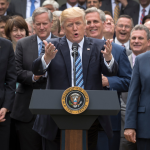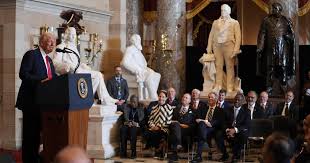Donald Trump’s election in 2016, New York has experienced significant shifts in its economic landscape, particularly when it comes to unemployment rates.
While the overall trend has seen periods of growth and setbacks, the impact of the Trump administration’s policies on the state’s job market remains a topic of discussion among economists, policymakers, and residents alike.
Unemployment Before and After Trump’s Election
In the years leading up to Trump’s election, New York was witnessing a steady decline in unemployment rates. By the time Trump took office in January 2017, the state had seen its unemployment rate drop to historically low levels, hovering around 4.7%. This decrease was attributed to the economic recovery following the Great Recession of 2008, with job growth driven by industries such as technology, finance, and healthcare.
However, Trump’s presidency brought with it a series of changes that would shake up the U.S. economy, including New York’s job market. Tax cuts, deregulation efforts, tariffs, and trade wars—along with the unpredictable shifts of the COVID-19 pandemic—would soon create new challenges for employment in the state.
The Impact of Trump’s Policies on New York’s Economy
Under Trump’s leadership, a series of policies were introduced that had varying effects on the economy, some of which helped businesses and others that left sectors vulnerable to job loss.
- Tax Cuts and Economic Growth: The 2017 Tax Cuts and Jobs Act passed during Trump’s first year aimed to stimulate the economy by reducing corporate tax rates and cutting taxes for individuals. In theory, these cuts would lead to job growth and increased wages. For a brief period, New York, like many states, saw positive effects from this economic policy. Unemployment in the state dipped even further in the early years of Trump’s term, reaching a low of 4.1% by the end of 2018.
- Trade Wars and Economic Uncertainty: One of the most significant aspects of Trump’s administration was its focus on trade policy, particularly with China. The implementation of tariffs on foreign goods, along with the renegotiation of NAFTA into the USMCA, led to economic uncertainty for many businesses. In New York, industries such as agriculture, manufacturing, and retail were hit by the global trade tensions. This period of instability made it harder for certain sectors to maintain or grow jobs, leading to increased unemployment in specific industries.
- COVID-19 Pandemic and Widespread Job Loss: The global pandemic was a game-changer, resulting in severe economic consequences that far outlasted Trump’s tenure. New York, in particular, was one of the hardest-hit states in terms of both health and economic impact. Unemployment skyrocketed, peaking in April 2020 at a staggering 14.5%. While the pandemic cannot be entirely blamed on Trump’s administration, the response to the crisis—including limited federal support and an initial lack of coordinated strategy—left millions of New Yorkers without work. Businesses shuttered, and many people in the service, hospitality, and entertainment industries found themselves out of work, while others faced cuts in hours and wages.
Unemployment Trends During the Trump Era
Kentucky Sees 21% Spike in Unemployment Rate Compared to Last Year
While the pandemic drove a significant spike in unemployment, the recovery period also revealed important shifts. Under Trump, the job market initially saw substantial growth, but the benefits were not uniformly distributed. Some areas of the state experienced faster recovery than others, with more urbanized areas like New York City benefiting from more stable employment, while rural parts of the state struggled with job losses in agriculture and manufacturing.
By the end of Trump’s presidency, New York’s unemployment rate had fluctuated dramatically, but the long-term effects of the policies he implemented were still being felt. The job market began to show signs of recovery, but the growth was uneven.
The Transition to the Biden Administration
When President Joe Biden took office in 2021, New York’s unemployment rate remained elevated due to the lingering effects of the pandemic and economic instability. However, with Biden’s new relief packages and policies aimed at stabilizing the economy, the state began seeing gradual improvements in employment.
Biden’s emphasis on stimulus payments, extended unemployment benefits, and investments in infrastructure provided a lifeline to many residents, while Trump’s final years saw a less coordinated federal response to the crisis. The job market in New York has begun to recover, but it’s clear that the Trump-era policies contributed to lasting challenges in various sectors, particularly in those hardest hit by the pandemic.
The Future of New York’s Job Market
While New York has seen some improvement in its unemployment rate since Biden took office, the state is still grappling with the long-term effects of economic instability during Trump’s presidency. Many of the job losses and challenges in various industries—such as tourism, hospitality, and small businesses—may take years to fully recover.
It’s important to note that the post-Trump landscape offers a complicated outlook for New Yorkers. The pandemic’s aftereffects, combined with national shifts in labor trends and automation, mean that many sectors will need to adapt quickly to the new economic realities.
New York’s unemployment rates have undoubtedly been impacted by the policies and events that occurred during Trump’s time in office. While some aspects, such as tax cuts and deregulation, initially led to job growth, the COVID-19 pandemic and global trade uncertainties brought severe setbacks that led to unprecedented job losses across the state.
As the state continues to recover, the lessons learned from this period will likely shape future economic strategies, both at the state and federal levels. With the job market showing signs of recovery, New Yorkers remain hopeful that the path forward will focus on stability, equitable growth, and resilience in the face of future challenges.




























+ There are no comments
Add yours